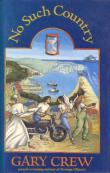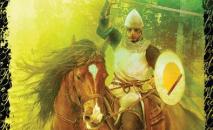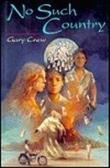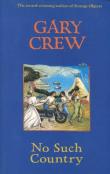AustLit
Latest Issues
AbstractHistoryArchive Description
'The title may be a literal translation of "utopia," but the isolated Australian fishing village of New Canaan is anything but–as Rachel and Sarah, two teenaged residents, and Sam, a visiting student, discover. Following a clue uttered by his mother (an aborigine) on her deathbed, Sam has come to track down his father and family; but his inquiries are met with silent suspicion by the twisted, disturbed locals, all white. Crew gradually builds a charged atmosphere lit by signs and portents of what's to come. Led by Sarah's half-deranged mother, Sam and his young friends uncover a mass grave concealed in a thicket of lantana and later find the town's awful secret laid out pictorially in an eerie codex; 20 years ago, in a drunken frenzy, the men captured the last local aborigines in a huge net and drowned them. After this revelation, Crew creates an apocalyptic climax in which a nearby volcano erupts, destroying grave, book, and an enigmatic, white-robed religious leader known only as The Father–a literal title, it turns out, in Sam's case.'
Source: Kirkus Reviews (https://www.kirkusreviews.com/book-reviews/gary-crew/no-such-country/). (Sighted: 30/11/2015)
Publication Details of Only Known VersionEarliest 2 Known Versions of
Other Formats
- Also sound recording.
Works about this Work
-
y
 Death, Gender and Sexuality in Contemporary Adolescent Literature
New York (City)
:
Routledge Taylor & Francis Group
,
2009
Z1790145
2009
single work
criticism
Death, Gender and Sexuality in Contemporary Adolescent Literature
New York (City)
:
Routledge Taylor & Francis Group
,
2009
Z1790145
2009
single work
criticism
-
'There's a Black Boy Dead and a Migloo Holding a Gun' : Death, Aboriginality and History in Australian Adolescent Literature
2009
single work
criticism
— Appears in: Papers : Explorations into Children's Literature , vol. 19 no. 1 2009; (p. 5-16) 'In 'Preying on the Past: Contexts of Some Recent Neo-Historical Fiction', Peter Pierce argues that, over the last five or so decades, Australian historical fiction has turned away from 'unconstrained and idealistic affirmations about Australia's future' to empathise instead with those figures in the historical landscape who were previously marginalised: 'victims of imperialism, patriarchy, racism, capitalism' (p.307).
This trend is particularly applicable to historical literature for younger readers, which now often tries to renegotiate history by providing a counterpoint to the metanarratives of the past (Stephens 2003, xii-xiii). Reflecting and responding to developments in the disciplines of historiography and, more generally, the humanities, texts in this genre are representative of the attempt to interrogate monolithic versions of Australian history - often called the 'three cheers' view - in which positivity, achievement and the peaceful settlement of the nation are key themes.
At issue in these novels is thus the redressing of past wrongs, particularly with respects to the violent aspects of colonisation when so many members of the Indigenous population either died or were forcibly displaced. Each of the three adolescent novels I focus upon in this paper - Melissa Lucashenko's Killing Darcy (1998), Gary Crew's No Such Country (1991) and Mark Svendsen's Poison Under Their Lips (2001) - is equally idiosyncratic in its approach to narrativising Australia's problematic colonial past' (Author's abstract). -
y
 New World Orders in Contemporary Children's Literature : Utopian Transformations
Houndmills
:
Palgrave Macmillan
,
2008
Z1559477
2008
selected work
criticism
'New World Orders shows how texts for children and young people have responded to the cultural, economic, and political movements of the last 15 years. With a focus on international children's texts produced between 1988 and 2006, the authors discuss how utopian and dystopian tropes are pressed into service to project possible futures to child readers. The book considers what these texts have to say about globalisation, neocolonialism, environmental issues, pressures on families and communities, and the idea of the posthuman.' - Back cover.
New World Orders in Contemporary Children's Literature : Utopian Transformations
Houndmills
:
Palgrave Macmillan
,
2008
Z1559477
2008
selected work
criticism
'New World Orders shows how texts for children and young people have responded to the cultural, economic, and political movements of the last 15 years. With a focus on international children's texts produced between 1988 and 2006, the authors discuss how utopian and dystopian tropes are pressed into service to project possible futures to child readers. The book considers what these texts have to say about globalisation, neocolonialism, environmental issues, pressures on families and communities, and the idea of the posthuman.' - Back cover.
-
No Such Country-- A Book of Antipodean Hours
Bernard McKenna
,
Sharyn Pearce
,
1999
single work
criticism
— Appears in: Strange Journeys : The Works of Gary Crew 1999; (p. 96-127) -
Identity in Australian Children's Literature: Perspectives from the Past and Present
1999
single work
criticism
— Appears in: The Fantastic Self : Essays on the Subject of the Self 1999; (p. 104-110)
-
Untitled
1992
single work
review
— Appears in: Reading Time : The Journal of the Children's Book Council of Australia , vol. 36 no. 2 1992; (p. 27)
— Review of No Such Country : A Book of Antipodean Hours 1991 single work novel -
Forecasts
1991
single work
review
— Appears in: Australian Bookseller & Publisher , August vol. 71 no. 1018 1991; (p. 36)
— Review of No Such Country : A Book of Antipodean Hours 1991 single work novel -
From the Word Go : books for younger readers
1991
single work
review
— Appears in: Australian Book Review , November no. 136 1991; (p. 53-55)
— Review of No Such Country : A Book of Antipodean Hours 1991 single work novel ; Del-Del 1991 single work novel -
Adolescents Bring Society to Its Knees
1992
single work
review
— Appears in: The Newcastle Herald , 18 January 1992; (p. 14)
— Review of No Such Country : A Book of Antipodean Hours 1991 single work novel -
Crisp Writing in a State of Humidity
1992
single work
review
— Appears in: The Courier-Mail , 9 May 1992; (p. wkd 6)
— Review of A Long Way to Tipperary 1992 single work novel ; No Such Country : A Book of Antipodean Hours 1991 single work novel -
Know the Author : Gary Crew
1991
single work
column
— Appears in: Magpies : Talking About Books for Children , September vol. 6 no. 4 1991; (p. 17-19) -
y
 New World Orders in Contemporary Children's Literature : Utopian Transformations
Houndmills
:
Palgrave Macmillan
,
2008
Z1559477
2008
selected work
criticism
'New World Orders shows how texts for children and young people have responded to the cultural, economic, and political movements of the last 15 years. With a focus on international children's texts produced between 1988 and 2006, the authors discuss how utopian and dystopian tropes are pressed into service to project possible futures to child readers. The book considers what these texts have to say about globalisation, neocolonialism, environmental issues, pressures on families and communities, and the idea of the posthuman.' - Back cover.
New World Orders in Contemporary Children's Literature : Utopian Transformations
Houndmills
:
Palgrave Macmillan
,
2008
Z1559477
2008
selected work
criticism
'New World Orders shows how texts for children and young people have responded to the cultural, economic, and political movements of the last 15 years. With a focus on international children's texts produced between 1988 and 2006, the authors discuss how utopian and dystopian tropes are pressed into service to project possible futures to child readers. The book considers what these texts have to say about globalisation, neocolonialism, environmental issues, pressures on families and communities, and the idea of the posthuman.' - Back cover.
-
'There's a Black Boy Dead and a Migloo Holding a Gun' : Death, Aboriginality and History in Australian Adolescent Literature
2009
single work
criticism
— Appears in: Papers : Explorations into Children's Literature , vol. 19 no. 1 2009; (p. 5-16) 'In 'Preying on the Past: Contexts of Some Recent Neo-Historical Fiction', Peter Pierce argues that, over the last five or so decades, Australian historical fiction has turned away from 'unconstrained and idealistic affirmations about Australia's future' to empathise instead with those figures in the historical landscape who were previously marginalised: 'victims of imperialism, patriarchy, racism, capitalism' (p.307).
This trend is particularly applicable to historical literature for younger readers, which now often tries to renegotiate history by providing a counterpoint to the metanarratives of the past (Stephens 2003, xii-xiii). Reflecting and responding to developments in the disciplines of historiography and, more generally, the humanities, texts in this genre are representative of the attempt to interrogate monolithic versions of Australian history - often called the 'three cheers' view - in which positivity, achievement and the peaceful settlement of the nation are key themes.
At issue in these novels is thus the redressing of past wrongs, particularly with respects to the violent aspects of colonisation when so many members of the Indigenous population either died or were forcibly displaced. Each of the three adolescent novels I focus upon in this paper - Melissa Lucashenko's Killing Darcy (1998), Gary Crew's No Such Country (1991) and Mark Svendsen's Poison Under Their Lips (2001) - is equally idiosyncratic in its approach to narrativising Australia's problematic colonial past' (Author's abstract). -
y
 Death, Gender and Sexuality in Contemporary Adolescent Literature
New York (City)
:
Routledge Taylor & Francis Group
,
2009
Z1790145
2009
single work
criticism
Death, Gender and Sexuality in Contemporary Adolescent Literature
New York (City)
:
Routledge Taylor & Francis Group
,
2009
Z1790145
2009
single work
criticism
-
The Architecture of Memory
1992
single work
criticism
biography
— Appears in: Australian Author , Autumn vol. 24 no. 1 1992; (p. 24-27) The Written World : Youth and Literature 1994; (p. 147-154)
- Coast,






